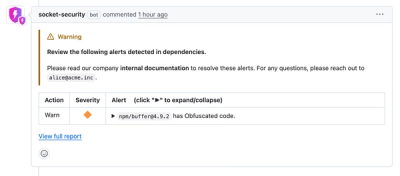
Security News
Crates.io Users Targeted by Phishing Emails
The Rust Security Response WG is warning of phishing emails from rustfoundation.dev targeting crates.io users.
clean-python contains abstractions for clean architecture in Python
It is independent of frameworks and has asyncio at its core.
The terminology used is consistently derived from the "Big Blue Book" (Domain Driven Design by E. Evans, 2004). Software consists of one or more modules, each having four layers: presentation, application, domain, and infrastructure. Each layer has its own responsibilities, in short:
A big inspiration for this was the easy typescript framework by S. Hoogendoorn and others
(https://github.com/thisisagile/easy).
The main goals of using layered architecture is isolating the domain-specific concepts from other functions related only to software technology. In this way:
Layers are loosly coupled with dependencies in only one direction: presentation > application > infrastructure > domain. In other words: the number of dependencies of the software's core business are as limited as possible.
A module may only depend on another module though its infrastructure layer. See InternalGateway.
This library was initially developed as a web backend using FastAPI. Its core dependency is pydantic,
for strict type parsing and validation. Optional dependencies may be added as needed.
The domain layer is where the model lives. The domain model is a set of concepts; the domain layer is the manifestation of that model. Concepts in the domain model must have a 1:1 representation in the code and vice versa.
THe layer does not depend on all other layers. Interaction with the infrastructure layer may be done
using dependency injection from the application layer. It is allowable to have runtime dependencies on the
infrastructure layer to set for instance default Gateway implementations.
There are 5 kinds of objects in this layer:
id and default fields associated with state changes ()created_at, updated_at).add / get / filter). This needs
a Gateway to interface with e.g. a database; an instance of a Gateway is typically injected into a
Repository from the application layer.Associations between objects are hard. Especially many-to-many relations. We approach this by grouping objects
into aggregates. An aggregate is a set of objects that change together / have the same lifecycle (e.g. delete together). One entity is the aggregate root; we call this the RootEntity. A ChildEntity occurs only very
rarely; mostly a nested object derive its identity from a RootEntity.
All change and access goes through the repository of a RootEntity. The RootEntity can be a complicated
nested object; how to map this to an SQL database is the issue of the infrastructure layer.
An infrastructure layer primarily contains Gateway objects that interface with a single external resource.
The Gateway implements persistence methods to support the domain and application layers. Much of the implementation will be in frameworks or other dependencies.
The methods of a Gateway may directly return a domain object, or return a dictionary with built-in types (Json).
Other gateway examples are: email sending and logstash logging.
The application layer defines the use cases of the application. Example use cases are create_user or list_user_roles. These methods have nothing to do with a REST API or command-line interface; this is
the business of the presentation layer.
In addition to directing the domain objects, an application layer method could trigger other behavior like logging or triggering other applications. At first, it may as well be just a single function call.
This layer is kept thin. It directs domain objects, and possibly interacts with other systems (for instance by sending a message through the infrastructure layer). The application layer should not contain fundamental domain rules.
The presentation layer shows information to the user and interprets the user's commands. Its main job is to get the application-layer use cases to be usable for an actual user.
The currently only option in clean-python is a REST API using FastAPI.
The primary objective of compartimentalizing code into modules is to prevent cognitive overload. The modules divide the domain layer, everything else follows. There should be low coupling between modules and high cohesion whithin a module. Modules are first and foremost a conceptual structure.
In Python, a module should be implemented with a single .py file or a folder of .py files (respectively called modules and packages).
Modules have a public API (presentation layer) and encapsulate their database. Only in this way the internal consistency can be guaranteed by the module's domain layer.
Our current approach is to have 1 aggregate (whose root is implemented as a RootEntity) per module.
clean-python can be installed with:
$ pip install clean-python
Optional dependencies can be added with:
$ pip install clean-python[sql,fastapi]
For local development of clean-python, clone the repository and cd into the directory.
Then, create a fresh virtual environment (using at least Python 3.10) and activate it. We recommend using PyEnv for that.
Then install the library in editable mode, with all optional dependencies:
$ pip install -e .[fastapi,auth,celery,fluentbit,sql,sql-sync,s3,s3-sync,api-client,amqp,nanoid,blinker,test]
N.B.: pip may have a hard time resolving some dependencies, if so, please use the convenience installation scripts referred to in the section below.
Finally run the unittests as follows:
$ pytest tests
For the integration tests, databases are necessary which are managed using docker compose:
$ docker compose up -d
$ pytest integration_tests
This package has all of its dependencies specified in the pyproject.toml file.
Most packages are specified with a minimum version (e.g. pydantic>=2.9).
In the automated tests both the minimum and the latest versions are tested.
Locally, the minimum and latest versions can be installed using convenience scripts, respectively scripts/install_minimum.sh and scripts/install_latest.sh.
The automated tests run every week, and if they fail (mostly due to an updated dependency), there will be an issue created automatically.
Locally, minimum and latest environments can be created using scripts in the scripts directory.
Use EXTRAS and PINS environment variables to tweak what is installed.
FAQs
Clean architecture in Python
We found that clean-python demonstrated a healthy version release cadence and project activity because the last version was released less than a year ago. It has 3 open source maintainers collaborating on the project.
Did you know?

Socket for GitHub automatically highlights issues in each pull request and monitors the health of all your open source dependencies. Discover the contents of your packages and block harmful activity before you install or update your dependencies.

Security News
The Rust Security Response WG is warning of phishing emails from rustfoundation.dev targeting crates.io users.

Product
Socket now lets you customize pull request alert headers, helping security teams share clear guidance right in PRs to speed reviews and reduce back-and-forth.

Product
Socket's Rust support is moving to Beta: all users can scan Cargo projects and generate SBOMs, including Cargo.toml-only crates, with Rust-aware supply chain checks.